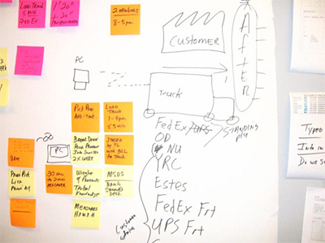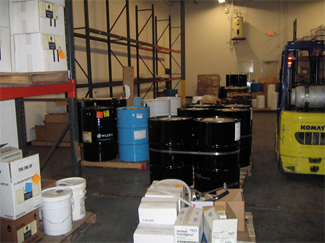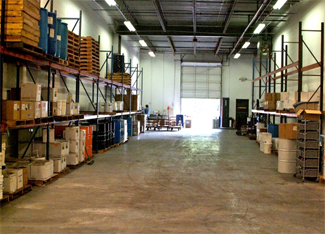EcoLink Inc. Lean Kaizen Event Case Study
Background
Ecolink is a 20-year-old company that designs cleaning processes and supplies cleaning products that are safer
and more efficient degreasers and solvents than traditional commercial products. Ecolink's clients include
manufacturers, aerospace companies, energy utilities, transportation providers, the military, and government
organizations. With eight full-time employees, Ecolink occupies an 8,000 ft2 distribution warehouse and 2,000
ft2 of office space.
Ecolink's approach to designing chemicals encompasses all phases of the chemical lifecycle to prevent pollution.
This niche service helps clients to adapt to chemical bans and phase-outs and reach their own sustainability goals.
Ecolink is a bronze member of the Partnership for Sustainable Georgia (PSG), a state program that assists Georgia
businesses in using continuous improvement tools to achieve better environmental results and a better bottom line.
Ecolink worked with the PSG and EPA to undertake a Lean Kaizen event on its administrative and warehouse processes
in 2009. Since discovering great savings through this event, Ecolink has also started providing "Opportunity
Assessments" for Lean savings to their clients and helping provide them with their own efforts to prevent
pollution and help them achieve their own sustainability goals
Problem Statement
In 2009, Ecolink moved from 45,000ft2 of shared warehouse space into its own 8,000 ft2 warehouse , bringing along
20 tractor-trailer loads of inventory. Some of these items were not even ordered by Ecolink, but had been left
behind by the last company to move out of the shared warehouse. Many items had been set down wherever they would fit
in the warehouse during the move, and there was little time to organize them because employees were so busy dimply
keeping up with each day's work.
Ecolink was also technologically backlogged, performing many functions manually and relying on paper based
communication. Caught in a complex and inefficient system, office staff sometimes forgot to charge clients for
freight or entered an order twice into their system.
Scope
Project Scope: Organize the entire warehouse using 5S techniques (described below), improve the ordering
process from the time a customer places an order until they have received the product and paid all fees,
and improve energy and water efficiency in the building.
Project Team: Ecolink Staff
Partners:
Partnership for Sustainable Georgia
- Suzanne Burnes, Assistant Director
- Diana Trettin, Program Manager
EPA Region 4
- Suganthi Simon, Pollution Prevention Coordinator
- Latoya Miller, Innovation Coordinator
Lean Works Contractor
Goals:
- Reduce touches and time in the order-to-cash cycle
- Eliminate search time and extra steps in the warehouse
- Create a Visual Control System in the warehouse
- Regain confidence in the system and protect profits
- Make Ecolink more sustainable
Solutions Developed
|
Ecolink's team used a combination of Value Stream Mapping and 5S to improve Ecolink's efficiency and
environmental sustainability.
|
|
Value Stream Mapping (VSM) breaks down a process into its fundamental steps and creates a visual
representation of how these steps relate to one another. Once this is accomplished, it is easier for the
team to pick out which steps add little or no value to the final product. With these steps eliminated,
the team can plan and map a new, more efficient process. The Ecolink team used VSM to optimize several
office processes.
|
| Ecolink used 5S, a process for making a workspace more efficient and productive, to organize its
warehouse. The 5 S's stand for: Sort, Set in Order, Shine, Standardize, and Sustain. |
- Sort: Look through all objects in a room, remove the unnecessary ones.
- Set in Order: Find a proper place for each object, label this place.
- Shine: Thoroughly and consistently clean the room.
- Standardize: Train employees and delegate responsibilities to ensure that the first three steps continue.
- Sustain: Keep the first four steps going.
|

This Value Stream Mapping exercise at Ecolink gave participants a visual representation of how the fundamental
steps in a process related to one another.
|
| Substantial savings were discovered as a result of the Ecolink Lean Event. Now an advocate for Lean, Chief Operating Officer
Brandon Pelissero said, "It's not just Pollution Prevention. It's Profit Protection." |
| Ecolink made the following changes because of the Lean event: |
| Accounting Software Optimization |
- Switched to accounting software with a duplicate order function that automatically fills in the information from a
previous order, but allows the user to tweak the order. Because most of Ecolink's clients make the same order many times,
this function greatly reduces manual data entry and guards against human error. Staff can also pull up the software while
on the phone or just after receiving an email and add the order immediately instead of jotting down notes for later use.
Putting ordering information straight into the system increases accuracy and reduces paper waste.
- Convinced 10% of customers and 80% of vendors to switch from traditional mail, faxing, and other paper-intensive
communication to electronic data interchange (EDI), electronic funds transfer (EFT), and email. Ecolink is also considering
a 5% discount to customers who commit to pay online with a credit card. This saved 40 hours/year, or $1,500, with the
added benefit of being paid faster.
- Altogether, this software optimization saved $16,500 annually.
|
| Logistics |
- Increased access to software and information technology so that staff have the authority to perform their
jobs more easily.
- Made email tracking a standard procedure. The majority of Ecolink's calls are from customers who want to
know why a shipment has not yet arrived. In order to improve customer peace of mind and reduce employee time spent
answering calls, Ecolink now emails the customer their invoice and tracking number as soon as their items are shipped.
This allows customers to check the progress of their shipment on the shipping company's website.
- Switched from "Prepay and Add" to a Customer Account. With "Prepay and Add," the customer pays for the product,
Ecolink ships it and the shipping company bills Ecolink, and then Ecolink bills the customer for shipping. Customer
Accounts are a much more efficient option, in which the customer pays Ecolink for the product and the shipping
company bills the customer directly. Besides saving time for Ecolink, this policy greatly reduces paper waste.
- "Touches" in the inventory, billing and ordering system by Ecolink staff were reduced from 118 to 26; a 78% reduction.
- Improved logistics enabled 78% fewer pages to be printed per order. This is a total of 55,200 pages per year,
and overall, about a 40% reduction, which saves 8 trees, 1,800 lbs of CO2, and 579 lb of solid waste.
(Calculated from the
Environmental Defense Fund's Paper Calculator,

and assuming 5g per sheet.
|
| Warehouse |
- Placed easy-to-read labels for each product on the shelves.
- Established a whiteboard for Visual Controls. The whiteboard lists the orders that are "ready to ship"
and "behind schedule" in different columns, allowing all employees to see how operations are progressing at a glance.
This greatly improved communication.
- Used 5S to organize everything and make inventory visible. The heaviest and most often shipped products are
now arranged closest to the door. A spare room is now used for miscellaneous items, giving Ecolink a good visual of
what items do not sell quickly and are therefore more risky to purchase.
- Relocated the printer closer to the warehouse to reduce time spent walking between the warehouse and the main office.
- Promoted alternatives to a particular shipping carrier. After realizing that 95% of damages were caused by one
shipping company, Ecolink began making a point of shifting its business to other shipping companies and letting its shipping
carriers know that continued business depends on their shipping products on time, keeping products undamaged, and not sending
products back to Ecolink.
- Eliminated unnecessary packaging prior to shipping, which reduced shipping weight, costs, and the need for customers
to manage packaging materials upon receipt of products.
- Began to routinely sign "Section 7" on the shipping form, which transfers responsibility for damages to the shipping
company.
- Logistics and warehouse improvements saved 2,000 hours per year and over $65,000.
|

The Ecolink warehouse before 5S.

The Ecolink warehouse after 5S.
|
| Energy Management |
- Installed a programmable thermostat to automatically turn down the heat or air conditioning during hours when
no one was working.
- Unplugged the hot water tank and signed up for the utility company's natural gas shut-off program, which
lasts from May 1 to October 15. The only office use of natural gas was to heat the building and heat water for
hand-washing, both of which Ecolink employees determined to be unnecessary in the summer. Now, Ecolink receives
no gas bill at all (including service charges) for five months of the year.
- Replaced break room microwave and other old, inefficient appliances.
- Unplugged several unused water fountains so that they no longer cool the water.
- Transitioned the computer server to virtual hosting at a data center.
- Improved energy management amounted to savings of 15,000 kWh or about 7 tons of coal, which is 28,000lb
CO2 and $6,000 in annual savings. (Assumes all electricity is produced by burning coal. Calculated from
US Energy
Information Administration's Voluntary Reporting of Greenhouse Gases Program,
 and assuming averaging the emission coefficients of all four coal types.
and assuming averaging the emission coefficients of all four coal types.
|
| Solid Waste Reduction |
- Arranged for empty metal drums to be taken back by supplier for free.
- Began reusing packaging boxes.
- Switched from purchasing 0% post-consumer office paper to 100% post-consumer office paper. For
Ecolink's yearly paper consumption of 80,000 pages, this conserves 11 trees and prevents 1082 lb CO2 and
317 lb of solid waste.
|
Annual Savings |
- Environmental: Save 19 trees, prevent 31,000 lb of CO2 and decrease solid waste by 900 lb
due to reduction in paper, electricity, and natural gas use.
- Time and Capacity: Save 2,600 hours and increased shipping capacity by 50% by improving
logistics and warehouse organization.
- Economic: $100,000
- Human Resources: Improved employee morale and confidence in Ecolink's business, brand, and staff.
|
Contact Information
Brandon Pelissero, COO
800-886-8240
bpelissero@ecolink.com
www.ecolink.com
Twitter: @EcolinkInc
Suganthi Simon
Pollution Prevention Coordinator
U.S. EPA, Region 4
404-562-9384
simon.suganthi@epa.gov
Top of page



![]()
![[logo] US EPA](../gif/logo_epaseal.gif)